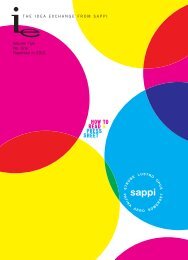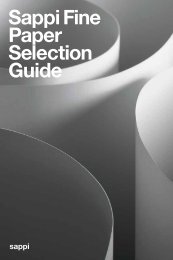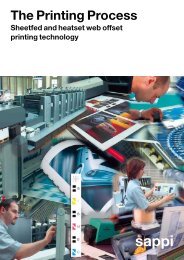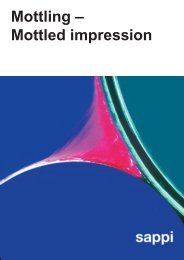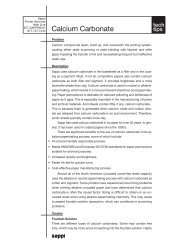Paper Standards Measur Umschlag - Sappi Mobile
Paper Standards Measur Umschlag - Sappi Mobile
Paper Standards Measur Umschlag - Sappi Mobile
Create successful ePaper yourself
Turn your PDF publications into a flip-book with our unique Google optimized e-Paper software.
Vll Others<br />
pH value ISO 6588<br />
The pH value in the data sheets defines the pH value of the<br />
surface. The pH values are indicated on a scale from 0 to 14.<br />
The measuring value 7 marks the neutral point which corresponds<br />
to distilled water. Values below 7 refer to “increasingly<br />
acid”, values above 7 stand for “increasingly alkaline”.<br />
<strong>Paper</strong>s should be close to, if possible, next to the neutral<br />
area or in the slightly alkaline range to have ideal requirements<br />
for printing and further treatment.<br />
Ash content ISO 2144<br />
The ash content is the remaining residue as percentage of<br />
dry paper after ignition at 900°C. The ash content is the total<br />
of inorganic material, like carbonate, kaolin etc. in the paper<br />
(including filler). Fillers have an important influence on the<br />
paper quality (for instance opacity) and are dosed with care<br />
depending on the application of the paper.<br />
Mottle test<br />
Mottling is the uneven print appearance, mostly in solid<br />
areas: small dark and light areas in the surface of paper<br />
(board) caused by ink, paper or printing press. Mottle is influenced<br />
by many parameters: e.g. ink, colour sequence,<br />
construction of printing press, speed, rubber blanket and<br />
fountain water. Variations in the surface characteristics such<br />
as absorption and smoothness play an important role<br />
regarding mottle and are caused by the production process<br />
and the components within the paper.<br />
There can be three kinds of mottle:<br />
Backtrap mottle<br />
Ink applied to paper surface on a preceding printing unit of a<br />
multi-colour press will split onto the blanket in a subsequent<br />
unit and then be re-deposited onto the next sheet. If this<br />
occurs unevenly, the print can become mottled.<br />
This backtrap mottle can be simulated on a test printing<br />
machine by printing the paper and countering the paper in<br />
pre-defined times against a clean blanket reel.<br />
Water interference mottle<br />
Water transferred to paper surface on a preceding printing<br />
unit of a multi-colour press should be absorbed by the coating<br />
before it reaches a subsequent printing unit. If it is not<br />
absorbed it will prevent even transfer of the ink. A mottled<br />
print can result.<br />
The method IGT ink repellence (see chapter VI Absorption)<br />
is used to test this phenomenon.<br />
Midtone mottle (screen mottle)<br />
This is an uneven print in 30–60% screens, caused by differences<br />
in the scattering and absorption behaviour of base<br />
paper and/or coating. This effect can occur in one colour<br />
printing and even in case of perfectly formed dots of equal<br />
density (optical effect).<br />
Midtone mottle can be evaluated by printing a screen with<br />
the test printing machine or with help of a plastic screen<br />
which is put on top of the paper. The level of screen mottle<br />
can be evaluated visually or with help of image analysis.<br />
13



